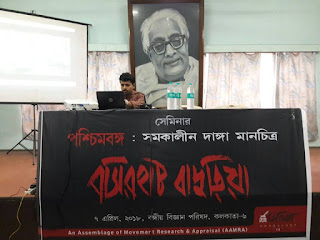Background score:
AAMRA had organised a seminar centering on Basirhat-Baduria
violence. On 7th April 2018 at Bangyo Biggyan Parishad Bhavan. The seminar was
aimed at having a discourse on the recent events of polarisation in West Bengal
beginning with events of religious conversion in Birbhum, through the aspects
of Kaliachak violence, Dhulagarh incident and dimensions of
Naihati-Hajinagar-Chandannagore to the most recent events of Asansol-Ranigung.
We have conserdered Basirhat-Baduria as a case in the broad spectrum of
relisious polarisation of West Bengal. Basirhat-Baduria is one of the typical
cases baecause of three reasons, first, the event showed considerable evidence
of organised polarisation, second, it begin with one of the most recent trends
of polarisation, i.e., through social media and third, the conflict continued
for a considerable period of time.
While focusing on the case, our attempt was centered on a)
somewhat detailed account of the events of Basirhat-Baduria, b) unearthing of
some of the major themes and domains of Basirhat-Baduria having generalised
trends, and c) an attempt to map the existing forms of polarised practices in
West bengal through the lens of broad social-scientific dimensions of conflict
studies.
 |
| Book cover of the Basirhat-Baduria report |
The event:
It was one of the first major thunderstorms taking place
outside when AAMRA started the seminar. The weather became cool but of course,
we were skeptical about people's attendance. However, as the event began we
could see the seminar hall is filled with interested and interactive listeners.
The seminar began with showing a a documentary entitled "Hok-er Ghor"
by Faqrul-Arefin followed by a little discussion on the movie. We then quickly
move towards our main event which is as follows.
Subhapratim Roychowdhury talked about AAMRA'S missions and
how far the organisation has been able to meet its aims. Then he concentrated
on the recent issues of polarisation in west bengal and elsewhere.
Md Faruqueul Islam gave a quick summary on the Basirhat and
Baduria and pointed how AAMRA is methodologically different fron other media
houses.
Suman Nath made a presentation of the major qualitative
dimensions of the Basirhat and Baduria violence along with narratives from the
fieldwork.
Mohit Ranadip gave intricate details of the nature of
fissure, mistrust between the communities and possible psychosocial
predispositions.
Irfan Engineer gave adequate foundation of linking
polarisation politics in India and put West Bengal into perspective.
Giasuddin talked on the importance of focusing on all forms
fundamentalisms in india and how civil society needs a greater role to play.
Finally Abhro Ghosh concluded by focusing on how social
cultural dimensions needs to be taken up seriously because otherwise these
mechanisms are systematically used by the fundamentalist forces.
Questions were asked how it is time for mapping these
smaller and localised incidents in global perspectives.
What lies beyond:
Well, while we were working on the seminar, busily arguing
on issues related to polarisation, disturbing events were surfacing at much
greater scale centering on the event of Ram Nabami. AAMRA, immediately after
finishing the seminar decided to go for a visit to Asansol where riots had take
place. On the next day, a team of researchers from AAMRA went to make a visit
to Asansol finding it another beginning of such studies.
A few photographs are given in the below.











